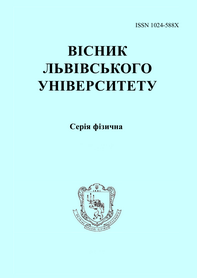DOI: https://doi.org/10.30970/vph.55.2018.50
Structure and refractive parameters of doped K2SO4 crystals
R. Matviiv, M. Rudysh, V. Stadnyk, R. Brezvin, I. Matviishyn, L. Karpliuk

| Visnyk of the Lviv University. Series Physics
55 (2018) ˝. 50-61
DOI: https://doi.org/10.30970/vph.55.2018.50 Structure and refractive parameters of doped K2SO4 crystalsR. Matviiv, M. Rudysh, V. Stadnyk, R. Brezvin, I. Matviishyn, L. Karpliuk |  |
Potassium sulfate crystals doped by 3\% copper were synthesized, and their dispersion dependences of refractive index ni(\lambda) and birefringence \Deltani(\lambda) were investigated. It has been established that in the spectral range 300 ... 700 nm the dispersion ni(\lambda) is normal. Doping of the impurity leads to a decrease in ni, causes a shift in the position of the centers of ultraviolet oscillators in the long-wavelength region of the spectrum, a decrease in the strength of the corresponding oscillators, the values of refraction of the bonds and electron polarizability. It has been established that the relation between the magnitudes and the dispersion changes of ni for pure and impurity crystals remains unchanged. Doping of the impurity leads to an increase of \Deltani along two directions X, Y and a decrease along the Z direction. It has been shown that the doping of the impurity significantly changes the absolute value of \Deltani without changing the nature of the dispersion. The X-ray powder diffraction method found the parameters of an elementary cell and calculated its volume. It is shown a slight increase in the volume of the elementary cell relatively to pure crystal that is the metric of the crystalline structure remains not deformed. It is established that the crystalline structure of the impurity crystal can be considered as the result of a multiple heterovalent substitution of two potassium atoms 2K+ into one Cu2+ copper atom in the structure; Copper atoms are on the verge of tetrahedral and octahedral cavities of the second coordination environment, they are close to the edge of the lower tetrahedron, and with the upper tetrahedra have weakened bonds; for copper atoms occupied by them positions are too large and they have space for thermal oscillations and the possibility of movement along the atoms of the metal component.